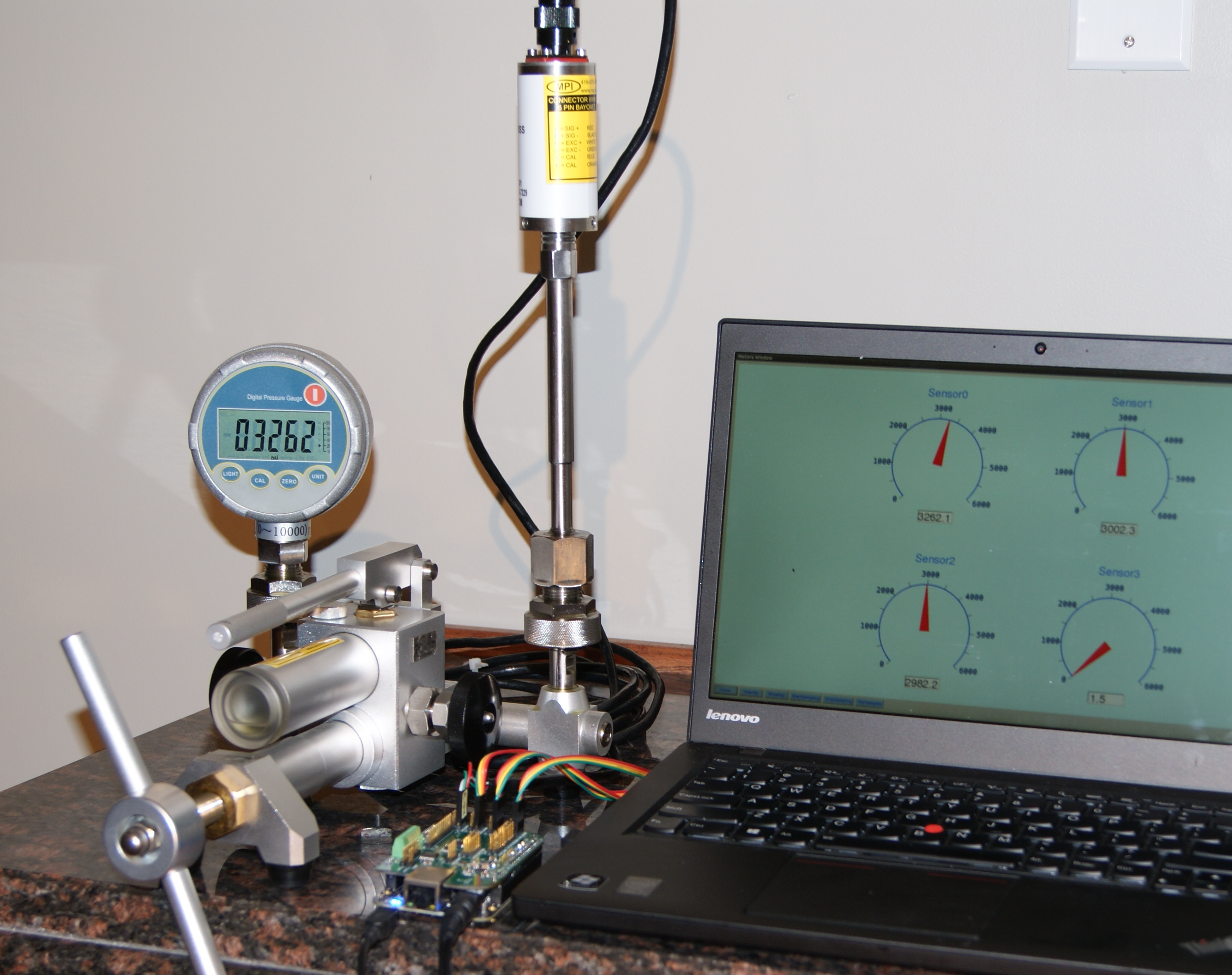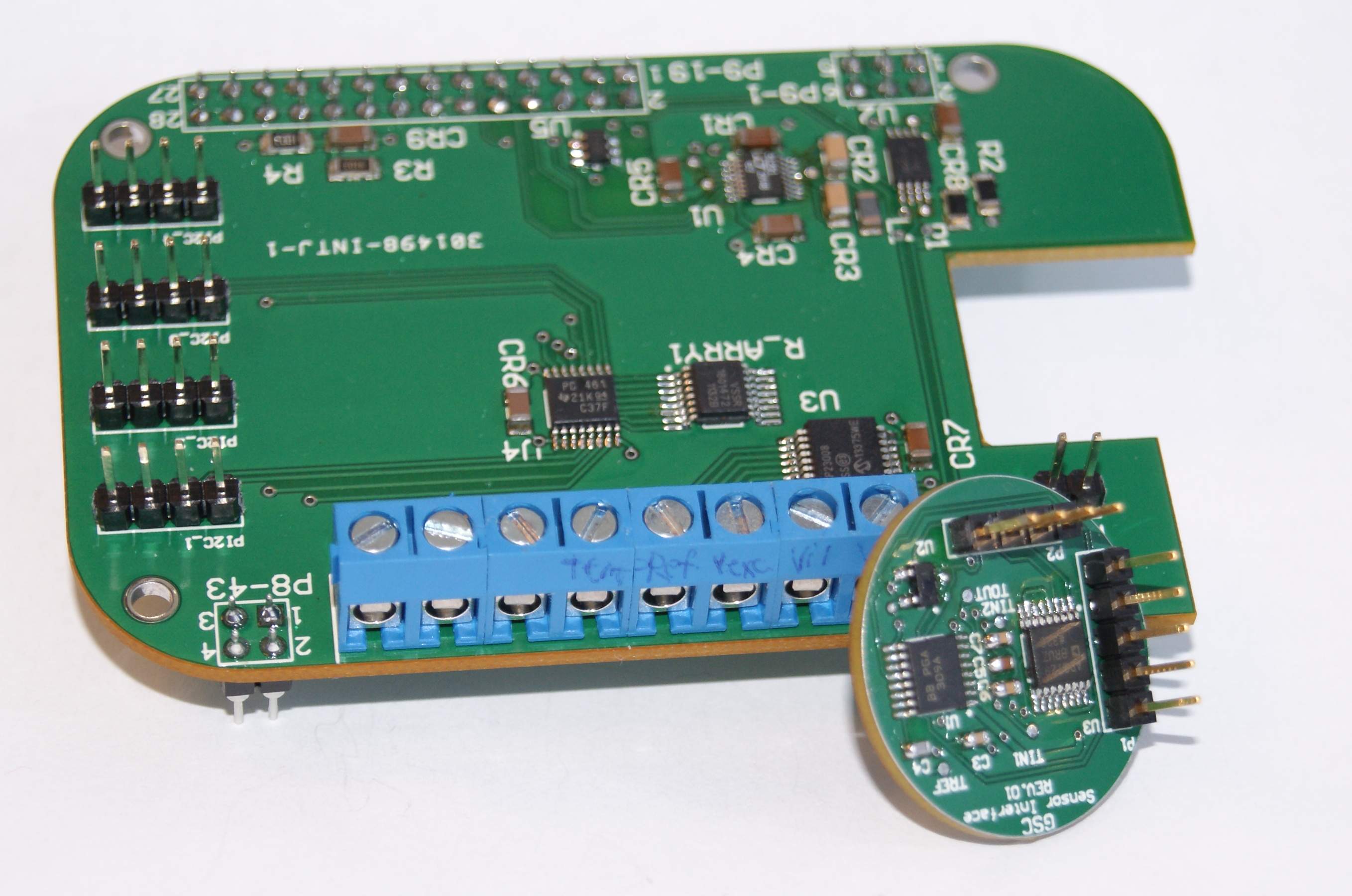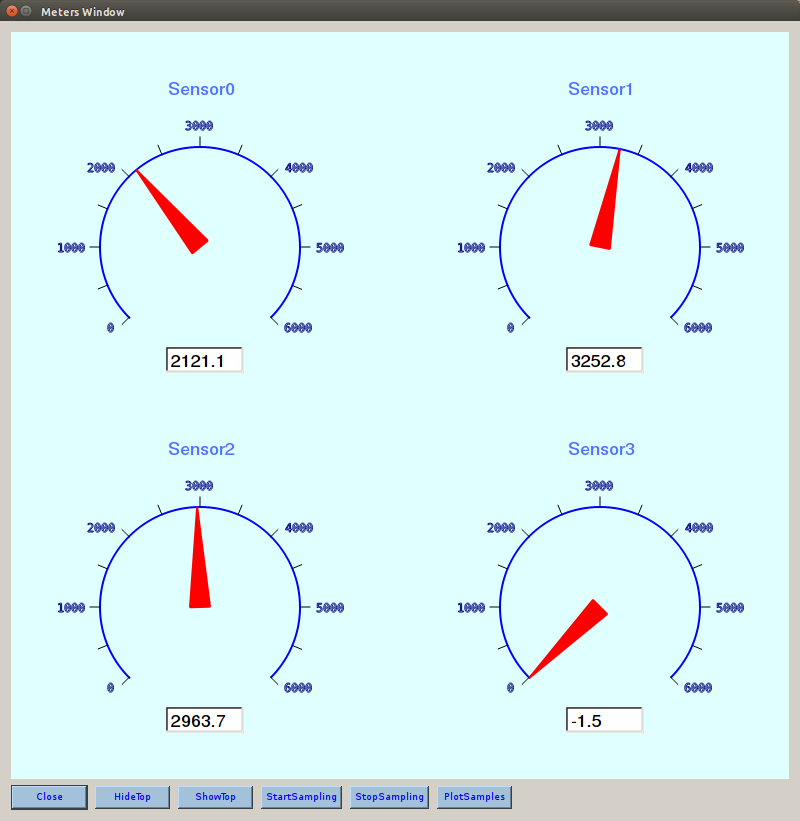
Sensor
Interface Conditioners (SICs) For Distributed Intelligent
Sensor Systems (DISSs)
Many
industrial sensors are realized using Wheatstone Bridges; in
these cases, the sensors, being variable resistors, have
their signals reflected as small differential voltages with
maximum output voltages in the range of 25-50mV. The
function of a Sensor Interface Conditioner
(SIC) is to amplify and condition these signals so they
can be communicated to an output device; often this means
a computer that might be a significant distance from the
sensor (possibly in a different geographic location). The
SIC is usually close to the sensor, and traditionally the
communication to the output device would be done using the
industry standard 4-20mA 2-wire interface. Only recently,
are SIC's becoming available where the communication to
the output device is done using digital signals
and a serial interface. Granite SemiCom Inc. (GSC) has
developed a SIC with specifications close to the best in
the industry, where the digital signals are
transmitted to a
small computer board using an I2C digital serial link. GSC has also developed a Demonstration
System based on
Distributed Intelligent Sensor Systems (DISS's) that teaches how to use the SIC's and to
verify their excellent specifications, that
can be used to
program the SIC's using either a Graphical User Interface
(GUI) or a script from a file (or both), and that can
also be used to remotely control
and debug DISS's
from locations almost
anywhere on earth;
as long as an Internet
link exists. Shown is a high-pressure sensor that contains
GSC's SIC and communicates the the shown small-board
computer, which then communicates to the host computer
over a USB cable; CAT-5 and WiFi connections to the host
are also supported.
Sensor Interface Conditioner
 Shown
is GSC's
SIC being evaluated for use as the interface to an
Industrial High-Pressure Sensor produced by MorHEAT Inc. (www.morheat.com)
for “Melt
Pressure”
applications;
GSC''s SIC is inside the sensor housing and connected to a
smart computer board using the I2C
interface; the
demonstration software all runs on the computer board but the higher levels can run
on remote host computers.
In the Demonstration
System, with all the GUI software running on the small
computer board, the
output of the software is communicated to a host computer
using a secure encrypted link based on the SSH
protocol with the -X option specified (that allows remote
X-windows viewing). In this picture, the SSH connection to
the host computer is through a USB cable; alternatives
that have been developed are through 100Mbs Ethernet
cables or wirelessly using WiFi. Any
controller or smart computer board that supports I2C can
be connected to GSC's SIC; for
the Demonstration System,
the controller is based on using the Beaglebone Black
computer with a Controller Interface
Board (CIB) also
developed by GSC and supplied with its Demonstration
System. The CIB allows for 4 SIC's to be
interfaced with a single board; it also has an 8-bit GPIO
parallel interface, temperature sensor, programmable power
supply, and supply voltage and
temperature measurement
feedback for robust operation and remote
debugging.
Shown
is GSC's
SIC being evaluated for use as the interface to an
Industrial High-Pressure Sensor produced by MorHEAT Inc. (www.morheat.com)
for “Melt
Pressure”
applications;
GSC''s SIC is inside the sensor housing and connected to a
smart computer board using the I2C
interface; the
demonstration software all runs on the computer board but the higher levels can run
on remote host computers.
In the Demonstration
System, with all the GUI software running on the small
computer board, the
output of the software is communicated to a host computer
using a secure encrypted link based on the SSH
protocol with the -X option specified (that allows remote
X-windows viewing). In this picture, the SSH connection to
the host computer is through a USB cable; alternatives
that have been developed are through 100Mbs Ethernet
cables or wirelessly using WiFi. Any
controller or smart computer board that supports I2C can
be connected to GSC's SIC; for
the Demonstration System,
the controller is based on using the Beaglebone Black
computer with a Controller Interface
Board (CIB) also
developed by GSC and supplied with its Demonstration
System. The CIB allows for 4 SIC's to be
interfaced with a single board; it also has an 8-bit GPIO
parallel interface, temperature sensor, programmable power
supply, and supply voltage and
temperature measurement
feedback for robust operation and remote
debugging.
Tthe GIC Sensor Interface Conditioner (SIC) is very high-accuracy, highly reconfigurable, and includes self-debug capability allowing for remote debugging in the event of failure.
Controller Interface Board
A Sensor Controller Interface Board (CIB) has also been developed, and is supplied as part of GSC's Demonstration System. The Demonstration System helps teach how to program the SIC's, and to demonstrate their functionality and accuracy. GIC's Controller Interface Board (often called a “Cape” ) connects to the Beaglebone Black (BBB) computer board available from Sparkfun (www.sparkfun.com) and other distributors. The BBB is relatively fast, has lots of memory, both RAM and non-volatile (a 4Gbyte eMMMC), enables connecting to the Internet for remote control and communication straight-forward, and with its Debian operating system, provides a wealth of open-source software that greatly minimizes development time. For example, secure encrypted communication to the Internet using SSH is used. However, using the BBB is just one alternative; the SIC's can alternatively be connected to any controller that has an I2C interface, and GSC with its Design Services Model readily supports program development for connecting to alternative controllers. GSC's Demonstration System includes a pre-programmed BBB and Cape Interface Board to simplify users getting started; the Demonstration System also includes 4 SIC's, and a Sensor Emulator Board including a pressure sensor.
The Controller Interface Board (CIB) allows four SIC's to be connected to the CIB and used at the same time, even when they have identical Device addresses. Indeed, each of the four I2C channels can also be connected to multiple Devices, but all Devices on a single channel must have unique addresses. The number of channels can be expanded on custom boards in response to a customer's request.
 The CIB has a programmable
power supply voltage, has an 8 pin GPIO, and has output
voltage verification and CIB temperature verification to
support remote verification of
correct functionality.
Alternative connections for the BBB controllers are
through USB cables, or wirelessly using either a WiFi
dongle or a Bluetooth dongle plugged into the BBB's USB
port. The GSC Demonstration System comes with software
that is all running
on the BBB itself to simplify getting started. In a
non-demonstration system, the top-level software would run
on the host computer (this is currently supported for some
operating systems), while the driver-level software
would run on the small-board
controller. In
this case, the required bit rate for communicating to the
controller is very low, in the range of
kbs. In the GSC Demonstration System, with all interface
software running on the BBB controllers, the host operates
just as an X-Windows display, and communications between the host and
the BBB controllers is done using the SSH
(Secure Shell) protocol
with the -X
option. This supports hosts with any operating system, and
is also highly secure with all communications to the BBB controllers
encrypted for
security. The down-side of running all software on the
BBB controllers is
higher data rate
connections to the controllers are needed (but these are still
modest data rates), and the controllers
need to have more capabilities (which the BBB controllers
do have). In applications where less powerful controllers
are used, the top level software would always run on the
host computer.
The CIB has a programmable
power supply voltage, has an 8 pin GPIO, and has output
voltage verification and CIB temperature verification to
support remote verification of
correct functionality.
Alternative connections for the BBB controllers are
through USB cables, or wirelessly using either a WiFi
dongle or a Bluetooth dongle plugged into the BBB's USB
port. The GSC Demonstration System comes with software
that is all running
on the BBB itself to simplify getting started. In a
non-demonstration system, the top-level software would run
on the host computer (this is currently supported for some
operating systems), while the driver-level software
would run on the small-board
controller. In
this case, the required bit rate for communicating to the
controller is very low, in the range of
kbs. In the GSC Demonstration System, with all interface
software running on the BBB controllers, the host operates
just as an X-Windows display, and communications between the host and
the BBB controllers is done using the SSH
(Secure Shell) protocol
with the -X
option. This supports hosts with any operating system, and
is also highly secure with all communications to the BBB controllers
encrypted for
security. The down-side of running all software on the
BBB controllers is
higher data rate
connections to the controllers are needed (but these are still
modest data rates), and the controllers
need to have more capabilities (which the BBB controllers
do have). In applications where less powerful controllers
are used, the top level software would always run on the
host computer.
Graphical User Interfaces
 The software interface to the
SIC's supports interfacing using either Graphical User
Interfaces (GUI's), using a script programming interface
where the programs are previously stored in files, or
optionally using both approaches. Detailed help on the
software interfaces is included in the extensive help files
of the GUI's supplied with the Demonstration System.
The software interface to the
SIC's supports interfacing using either Graphical User
Interfaces (GUI's), using a script programming interface
where the programs are previously stored in files, or
optionally using both approaches. Detailed help on the
software interfaces is included in the extensive help files
of the GUI's supplied with the Demonstration System.
The
software approach recommended by GSC is to separate the
details into three different Abstraction Levels: the User
Level, the Programming Level, and the Driver Level. For the
GSC Demonstration System, the User Level is a GUI showing 4
meters and digital readouts, one for each of the 4 sensors
attached to the CIB (Cape Interface Board). The User GUI has
buttons to start and stop sampling, to plot the results of
sampling, and to display
(or hide) the GUIs for lower levels of abstraction, namely
the Programming GUI (PGUI),
and Device Register
Interface GUI (DGUI).
The PGUI is displayed and changed when it is desired to
program the SIC's differently than their default values. The DGUI is only displayed,
and possibly changed, when the sensor interfaces are being
debugged. Both of these top level GUI's can be run
remotely assuming an Internet communication channel.
Availability
The Sensor Interface Conditioners (SICs) are available in minimum quantities of 10. The Demonstration Platform consisting of a pre-programmed Beagleboard Black computer board, a GSC Controller Interface Board (CIB), 4 SICs, and a Sensor Emulator Board is available in minimum quantities of 1. Please contact GSC for pricing information in both cases.
Sensor Interface White Paper
The SIC and CIB developed by GSC are described in more detail along with specifications in a White Paper.
© 2015 GSC